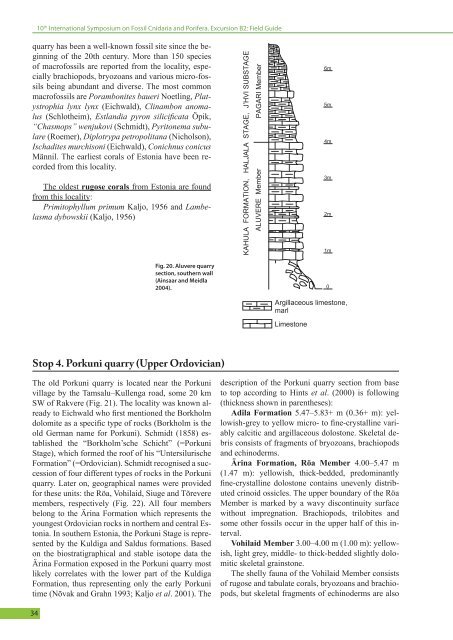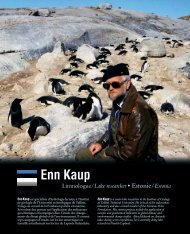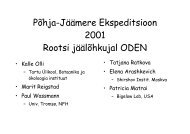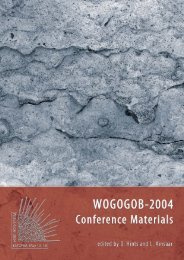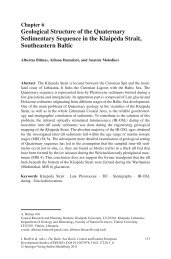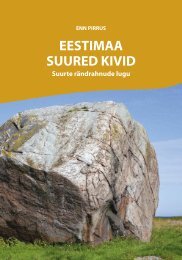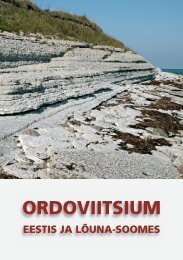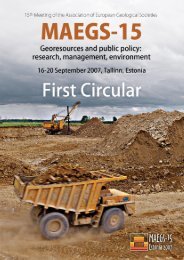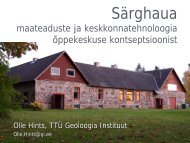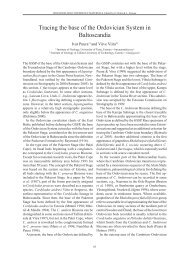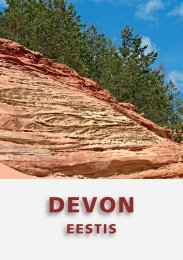Excursion Guidebook - Geoloogia Instituut
Excursion Guidebook - Geoloogia Instituut
Excursion Guidebook - Geoloogia Instituut
You also want an ePaper? Increase the reach of your titles
YUMPU automatically turns print PDFs into web optimized ePapers that Google loves.
10 th International Symposium on Fossil Cnidaria and Porifera. <strong>Excursion</strong> B2: Field Guidequarry has been a well-known fossil site since the beginningof the 20th century. More than 150 speciesof macrofossils are reported from the locality, especiallybrachiopods, bryozoans and various micro-fossilsbeing abundant and diverse. The most commonmacrofossils are Porambonites baueri Noetling, Platystrophialynx lynx (Eichwald), Clinambon anomalus(Schlotheim), Estlandia pyron silicificata Öpik,“Chasmops” wenjukovi (Schmidt), Pyritonema subulare(Roemer), Diplotrypa petropolitana (Nicholson),Ischadites murchisoni (Eichwald), Conichnus conicusMännil. The earliest corals of Estonia have been recordedfrom this locality.The oldest rugose corals from Estonia are foundfrom this locality:Primitophyllum primum Kaljo, 1956 and Lambelasmadybowskii (Kaljo, 1956)KAHULA FORMATION, HALJALA STAGE, J ’HVI SUBSTAGEALUVERE Member PAGARI Member6m5m4m3m2m1mFig. 20. Aluvere quarrysection, southern wall(Ainsaar and Meidla2004).0Argillaceous limestone,marlLimestoneStop 4. Porkuni quarry (Upper Ordovician)The old Porkuni quarry is located near the Porkunivillage by the Tamsalu–Kullenga road, some 20 kmSW of Rakvere (Fig. 21). The locality was known alreadyto Eichwald who first mentioned the Borkholmdolomite as a specific type of rocks (Borkholm is theold German name for Porkuni). Schmidt (1858) establishedthe “Borkholm’sche Schicht” (=PorkuniStage), which formed the roof of his “UntersilurischeFormation” (=Ordovician). Schmidt recognised a successionof four different types of rocks in the Porkuniquarry. Later on, geographical names were providedfor these units: the Röa, Vohilaid, Siuge and Tõreveremembers, respectively (Fig. 22). All four membersbelong to the Ärina Formation which represents theyoungest Ordovician rocks in northern and central Estonia.In southern Estonia, the Porkuni Stage is representedby the Kuldiga and Saldus formations. Basedon the biostratigraphical and stable isotope data theÄrina Formation exposed in the Porkuni quarry mostlikely correlates with the lower part of the KuldigaFormation, thus representing only the early Porkunitime (Nõvak and Grahn 1993; Kaljo et al. 2001). Thedescription of the Porkuni quarry section from baseto top according to Hints et al. (2000) is following(thickness shown in parentheses):Adila Formation 5.47–5.83+ m (0.36+ m): yellowish-greyto yellow micro- to fine-crystalline variablycalcitic and argillaceous dolostone. Skeletal debrisconsists of fragments of bryozoans, brachiopodsand echinoderms.Ärina Formation, Röa Member 4.00–5.47 m(1.47 m): yellowish, thick-bedded, predominantlyfine-crystalline dolostone contains unevenly distributedcrinoid ossicles. The upper boundary of the RöaMember is marked by a wavy discontinuity surfacewithout impregnation. Brachiopods, trilobites andsome other fossils occur in the upper half of this interval.Vohilaid Member 3.00–4.00 m (1.00 m): yellowish,light grey, middle- to thick-bedded slightly dolomiticskeletal grainstone.The shelly fauna of the Vohilaid Member consistsof rugose and tabulate corals, bryozoans and brachiopods,but skeletal fragments of echinoderms are also34


